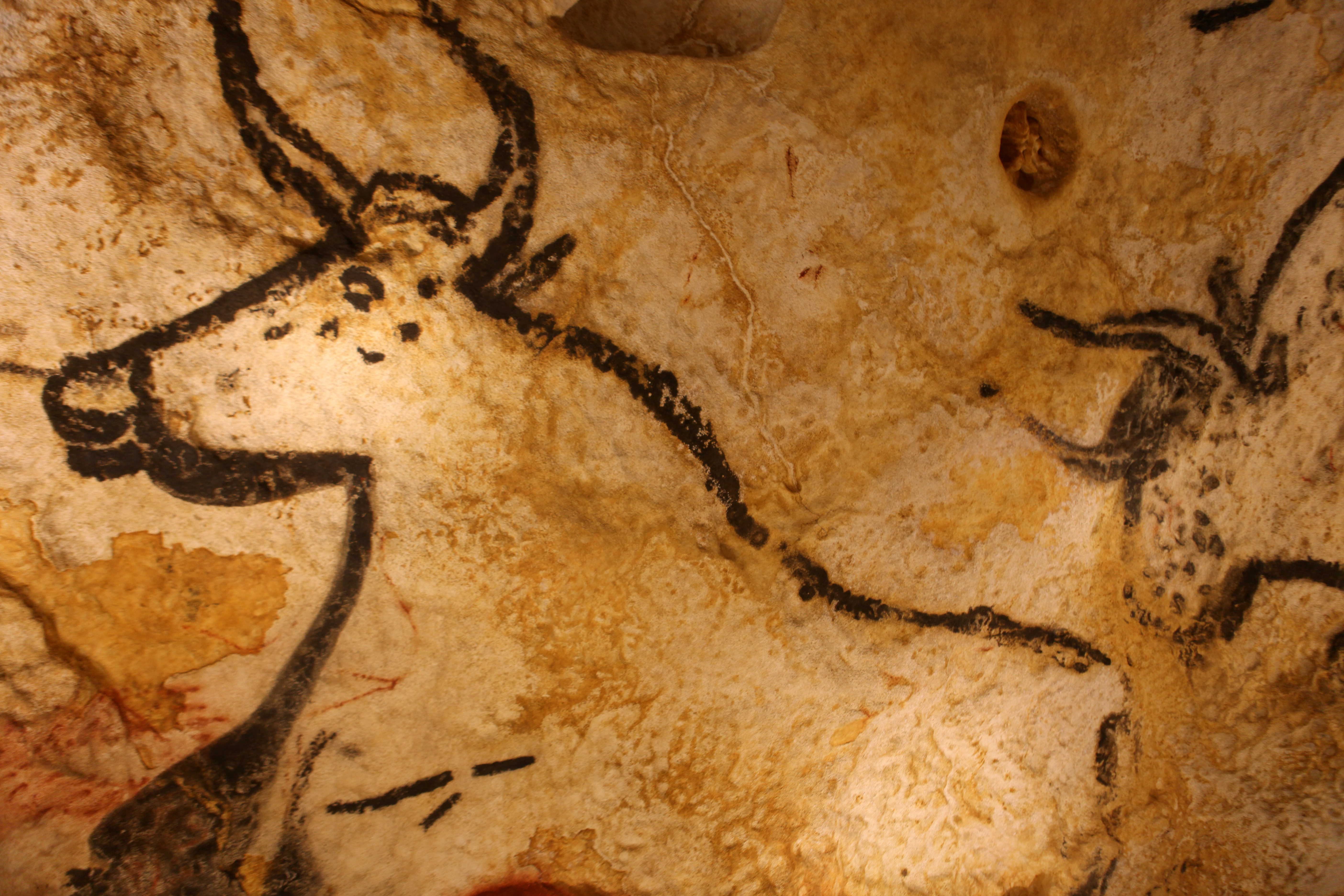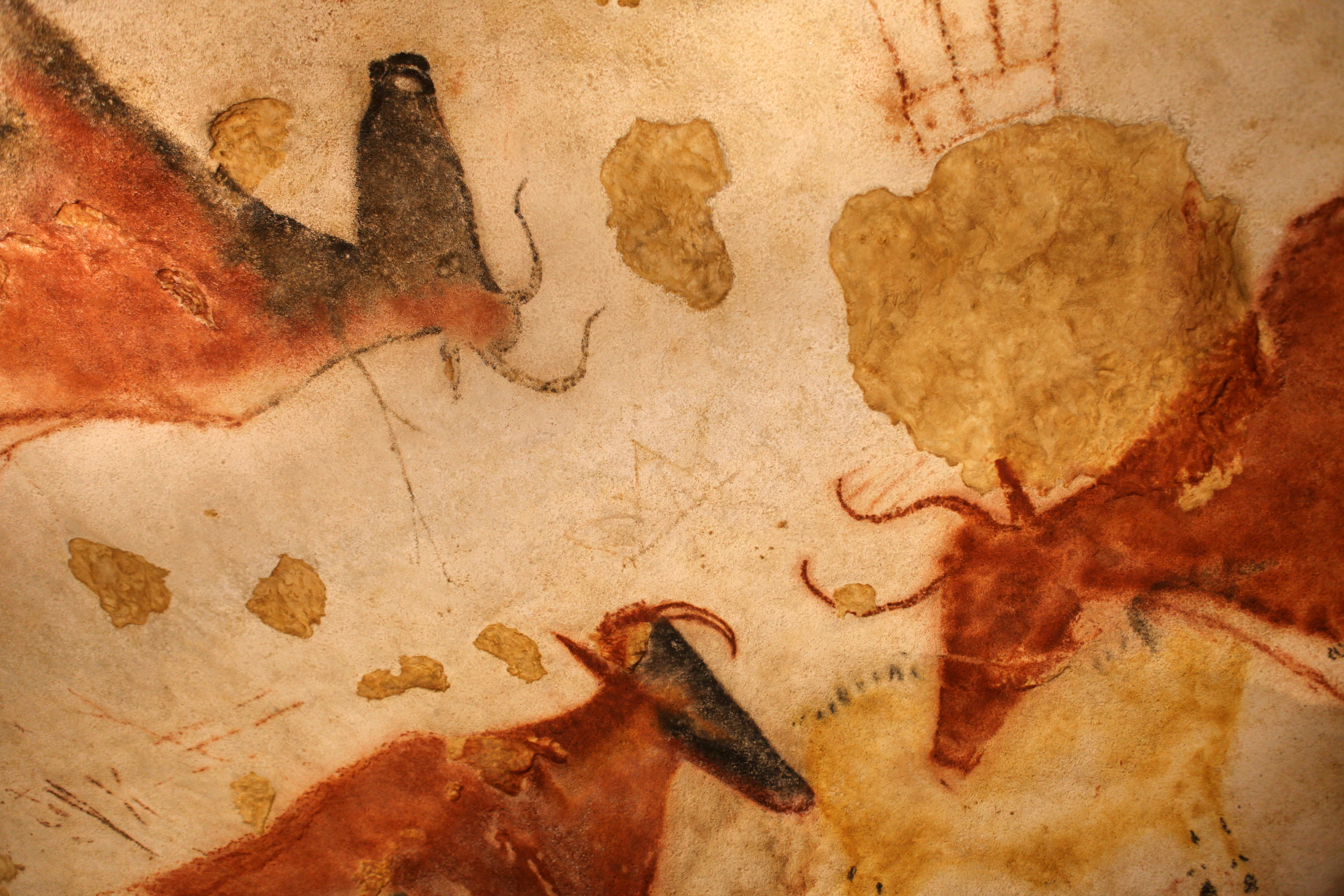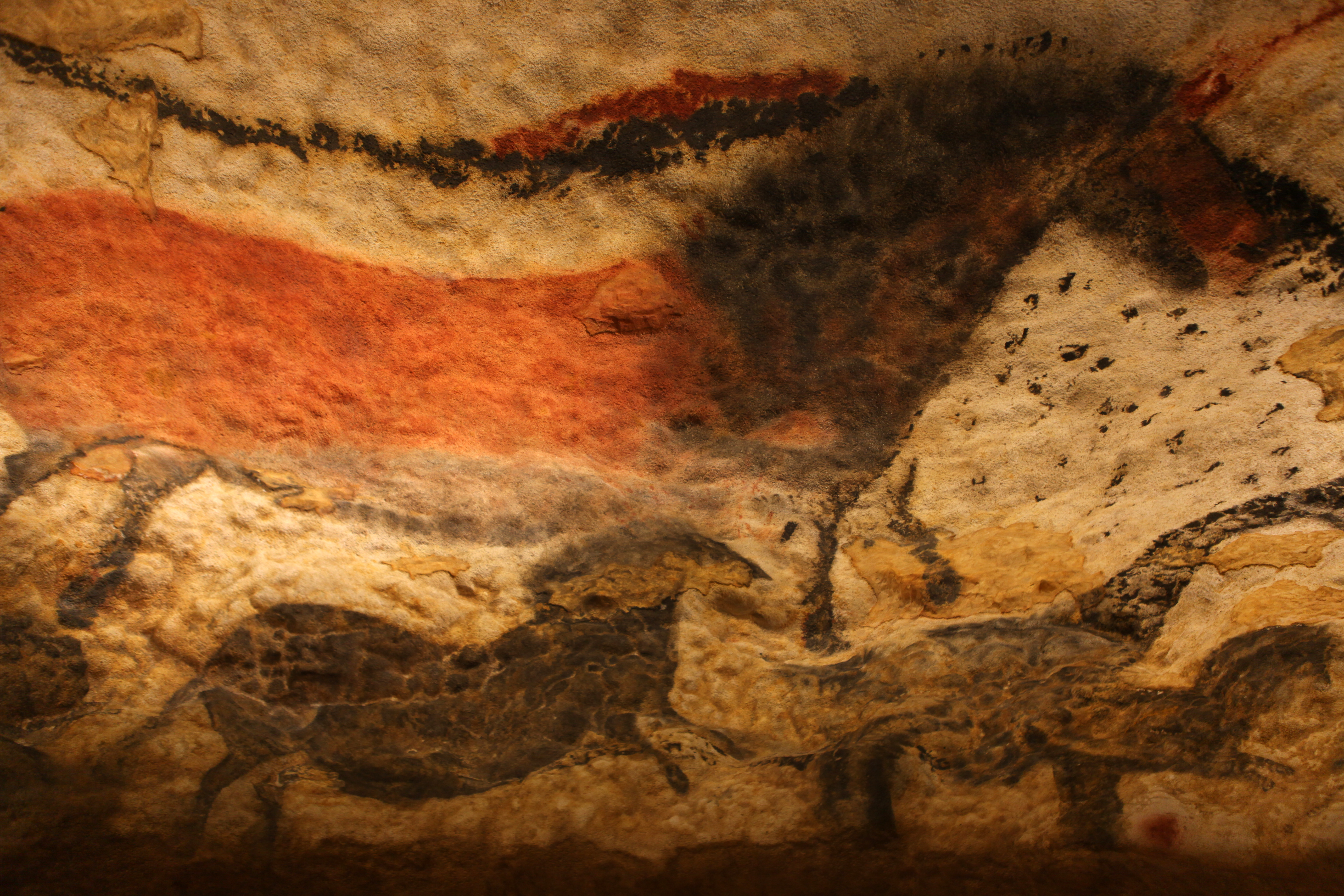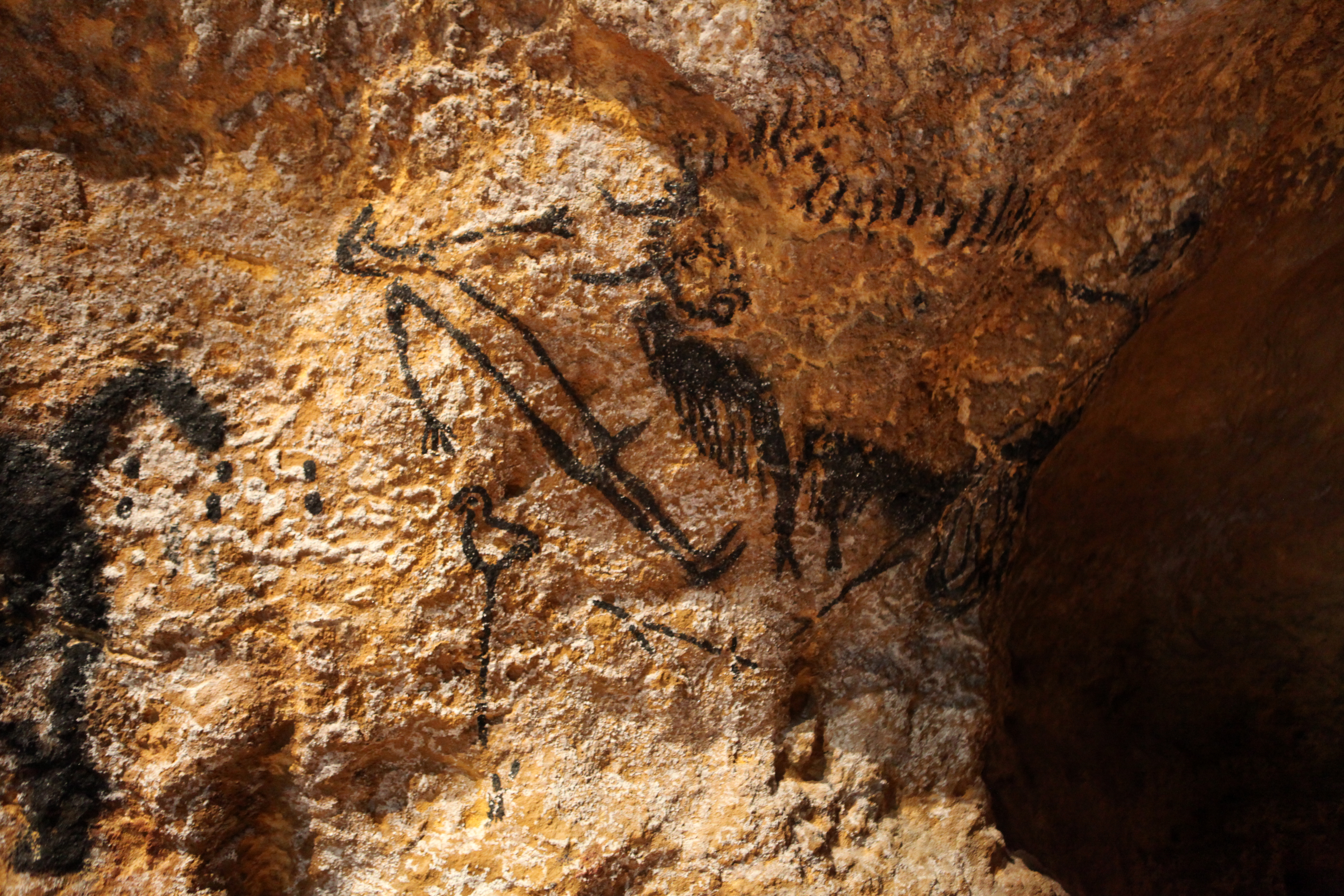THIRTY THOUSAND YEARS AGO CRO-MAGNON MAN made the final move from our treetop origins to live in caves, and though we coldly refer to them today in bland stepping stone terms, seeing as how the barbecue wasn’t invented yet, even going so far as to name our granddaddy ancestors Homo erectus, thereby accrediting their only meaningful accomplishment to posture, they gave their children such intimate names as Krog and Thag. Blah, blah, blah…You know how the rest of the story goes. A murderous monkey-man beats Cain to the punch, where after he tosses a bone up into the sky and, with a little help from Nietzsche and Zarathustra, it becomes one of Stanley Kubrick’s space ships.
When many of France’s ancient cave paintings began to be re-discovered in the late 19th century, some Darwinists cried foul on the basis that their opponents were attempting to deem the theory of evolution foolish. See, artists and art critics alike have long pointed out that the “cave man” paintings are so lush, so exquisite, and in such fine animated detail, that their techniques wouldn’t be replicated until the Enlightenment. These cave people not only had a taste for the arts—they were educated in them. The paintings were initially deemed forgeries. For nearly a century evolutionary propaganda insisted that our transitional ancestors were no better than head-clubbing cavemen, zealously dragging their version of a helpless Betty Grable type by the hair while her oblivious mate sleeps—a belief without merit, traces of which lingered even into my own childhood. Or maybe I simply watched that Ringo Starr Caveman movie one too many times.
Ever since I was a little boy, opening up the encyclopedia to “N” for Neanderthal, I’ve savored the opportunity to visit the world renowned cave paintings in southeastern France, particularly the grotto at Lascaux. It would take adulthood however to finally comprehend why Cro-Magnon man likely cringed whenever the holidays rolled around, any likewise why the fires would need dimming before their distant cousins, the Neanderthals, showed up.
This morning I woke my family up, having to take such measures as pulling the sheets completely off my children’s bed, and then drove them across the beautiful Dordogne valley. At Rouffignac, about 20 kilometers south from Lascaux, an electric mine train awaited us. As we slowly descended into the womb of the earth, our cart bumping and jolting through the primate darkness, we began to notice claw marks across its walls—in fact, thousands of them. Gigantic claw marks, hundreds and thousands of years of claw marks from bears, waking from their winter’s sleep, sharpening their knives for the first spring kill. Our train slithered and bumped through the ever widening and shrinking gorge of inner-earth for a couple of kilometers; more claw marks followed—and then I spotted them.
Even seconds before our guide flicked a light switch upon three distinct markings (he spoke French anyhow), I informed my sons: “Woolly Rhinos!”
It may have simply been several loose screws while the cart lumbered over the track, or perhaps my heart actually skipped a beat. That little boy in me, who’d flip from “P” for Pirate in the encyclopedia back to “N” for Neanderthal abruptly emerged—three decades instantaneously erased. The smell of old books in a library and the dried ink on a page finally faced the dank and dark impressions etched into my skull, except the living wet of each brush stroke was no longer shackled to my imagination. Dozens of woolly mammoths, entire herds of them—158 in total, raised their trunks and trumpeted while bison and horses and ibex danced and galloped with stunning vitality.
But I had questions which needed answered. I wanted to know why these particular paintings were accomplished so deep within the earth, and why animals? Why weren’t they painting their gods, and why were people rarely ever depicted? “N” for Neanderthal simply couldn’t quench my thirst, nor could this. I wanted to know what it all meant.
So I drove my family to the Grotto at Lascaux.

2
THE WORD PREHISTORIC EVEN TRANSLATES into French. Or maybe it’s aboriginal French and the English borrowed from it—seems plausible, if not likely. I would be hard-pressed to find a single word which the French willingly or even knowingly borrowed from anyone. Who really knows? My point is, all day while exploring the grottos at Rouffignac and Lascaux in the Dordogne valley of south-western France I heard their scholars, some English but all of them French speaking, referring to the ancient cave art and the people who painted them as Prehistoric.
As soon as we entered the mouth of each cave, first Rouffignac and then Lascaux, everything which followed, we were quickly informed, was Prehistoric. Consider my translating skills while our French speaking tour guide drove us deep into the womb of the earth onboard the Rouffignac train. French, French, French… More French… Prehistoric, French, French… Definitely more French, French… Prehistoric again, and then something else in French. Or as our second tour guide quipped, “Prepare to travel back in time, so far back that we’ll be arriving BEFORE the dawn of history.”
Oh dear. You mean history hasn’t even dawned yet, and already there were art schools? How about you just let me off in 1940, when a boy and his Labrador first discovered the cave we’re entering? Cubism was still all the rage then—that and art deco.
Anyhow, Prehistoric—the way it just runs off the lip. Each syllable, four in fact, practically smells of blackboards scribbled with sticks of calcium carbonate. Even our saliva drips with flavors of acumen. It was a phrase employed and ritually repeated over and over and over again in order to push and push, like a mommy in labor—JUST PUSH!—and then reinforce more laborious pushing until the evolutionary narrative takes root.
Kids, can everyone gather around on the carpet and say, Prehistoric?
No, kids! Stop! Just please, stop! Whenever your teacher says Prehistoric, just know that everything he’s about to tell you is getting pulled from his butt. By inferring that there was a time before RECORDED HISTORY the wizards in cloaks can now re-discover God’s story to their personal liking. More specifically, we grant them permission to program our present history—real history.
Congratulations kids, you’ve just won a date with the little red trolley and a trip to the neighborhood of make believe. Ding! Ding!
If Scripture never speaks of pre-history or even infers to the Prehistoric, it’s because “In the beginning God created the heavens and the earth (Genesis 1:1).” The Apostle John would phrase it like this, “In the beginning was the Word (John 1:1).” In the Greek we find Logos for the English Word. We might otherwise translate this as news, report, a saying, statement, message, or speech. In French—I had to look this up—Logos can be translated as Parole. The Word, or rather Parole, spoke. His creation week followed.
I like the way that flows right off the tongue—Parole.
Don’t you?

3
I HAD THE OPPORTUNITY TO CALL my friend Joe Taylor up on the telephone a couple of months ago, but more on that in a moment, because at present I had arrived with my family at the Lascaux grotto, seeking as you know answers. I asked Amalie our tour guide—we’ll just call her Amalie—how early man managed to paint such magnificent artwork on cave ceilings.
Amalie blushed, “Scaffolding.”
“Scaffolding…?” I tightened my lips, likely turning them side to side. “Like Michelangelo and the Sistine Chapel?”
“Yes,” she admitted, even going so far as to add: “In fact, many of these techniques, like depth of field, are still used in paintings to this very day.”
“I’m an artist,” Joe Taylor told me. Joe studied at the Art Institute of Chicago. “I can tell you when I see talent, and I can tell you when I see inexperience. A lot of these guys were so accurate, animals so well drawn—these guys were not lacking intelligence or ability.”
But I’m getting ahead of myself, because I haven’t quite gotten to Joe yet.
This is something which is well known among Cro-Magnon researchers, according to Amalie. Ancient man did not live in caves. Caves were too cold, too damp, without adequate food, and good luck kindling a fire. And besides, prehistoric man had the same sized brain as ours. He had art schools and blacksmithing schools and religion schools and, let’s just be honest here, fashion schools, and yet he didn’t think it important to record anything.
It’s a good thing I had already phoned this in.
“Whenever I think of the Neanderthal,” Joe Taylor told me before I even hopped on a plane, “they were the guys who lived right after Noah’s flood. Most of the caves are formed in limestone. They’re the layers that built up during the flood. Because some layers were softer, they would buckle when they began to crystalize. They would open up and water would come down and make a cave.”
Did this happen during RECORDED HISTORY, I asked myself. Check.
And speaking of RECORDED HISTORY, there were other dramatic changes after the flood, that is, beyond the landscape. Scripture records, or at least insinuates, that humans began to eat meat.
Joe continued: “After the flood, it took about 500 years for man to leave Babylon. They built boats, started going places. But when they got to Europe, they’re finding giant buffalo, giant sloth, all the things that eat vegetation and fruit. So if you’re going to live in France, you’ve got to eat the animals, because they eat the vegetation. So the cave men, they ate meat. If your diet basically consists of meat—that does something to your skull.”
“So after the flood everyone was superior physically, they were smarter, they lived longer, they lived to be 300 years old, so at 300 years your brow is gonna grow. Your lower jaw—you’re going to chew with the front of your skull at the end of your life as opposed to the back of it. Your head flattens out. But they had bigger brains, thicker bones. They weren’t very tall.” As if I didn’t have enough small talk conversation starters for my next party or mingling session, he added as a bonus: “Although there was a giant found in Israel, he was like, I don’t know, 8 feet tall or something, buried with armor on him. So the idea that Neanderthals were some sort of half human trying to get to be us is just not right.”
And then there was Amelie, our tour guide at Lascaux.
“They were highly intelligent,” she stressed.
Her position is that these grottos in France were temples for high priests and their initiates spanning a multitude of generations. It’s where the most sacred and mysterious of rites were enacted. The animals may have represented their gods, but far more likely themselves—their animals spirits, if you’d like. And just as likely, their divine selves.
Oh, Amelie! I thought, Stop playing games with my heart and thank you anyways! The paintings before me were already galloping and neighing, even snarling through their snotty nostrils with vibrant animation, but now, quite suddenly, she held a torch to the animal parade, and everything I knew of RECORDED HISTORY became illuminated. Indeed, it was the Babylonian Mystery religions which crackled and bathed the dance of beasts with fluorescent light so that the entire room began spinning in a carousel of glimmering paint and shadow. Much like the cave at Elysius or Pan’s Grotto, otherwise known as the gates of Hades, near Mount Hermon in Galilee, these were often believed to be entrance-ways to the underworld—realm of the Rephaim. It’s why they buried their dead there. It’s why they closed themselves up into the womb of the earth and partook in mind-bending psychedelics—that they might butterfly net their deepest and most intimate of spiritual enlightenments, and maybe even congregate with a god. Essentially, it was training for the final match. It’s always been about conquering death and awakening the immortal self, becoming divine—always.
No! No! No! Joe Taylor would surely stop me somewhere near the flickering torch light and it’s wrestling mat of shadows. It’s just art. And it is perhaps a fair analysis, one which he’s certainly not alone in. My only response to this is, When has art ever simply been art? I am of course speaking of ancient RECORDED HISTORY. But since we’re on the subject of art, past, present, or future, when has modern art ever really been art? And at the risk of sprinkling broken glass over your brain, can art that is relegated as something that’s relegated as simply art still be considered art?
“They were only a few hundred years from knowing about the flood and God. Did they get away from it?” Joe shrugged. “Maybe they did, maybe they didn’t.”
One way or another, however—since we’re dealing with the dice of RECORDED HISTORY—we can be quite certain that the cave people of southwestern France were slowly disbanding from Babel. We’re literally seeing the “confusion of tongues” in art form. To this we both can agree.
And I have a working theory.
On a practical level, call it simply art if we must, these nomadic Babel wanderers were taking inventory of what animals likewise disbanded from a centralized location in Turkey or Iraq or wherever the ark landed, likely close to Babel anyways, to the four corners of the earth. But there’s more. The animals are often depicted in herds—Duh, Noel—Migrating herds. If Amelie and her contemporaries are correct, then the esoteric undercurrent of these ancient paintings practically screams RECORDED HISTORY’s narrative.
The older I get, having studied Scripture and indulged in world cultures for decades now, I am continually amazed (I sit here awestruck as I clap these letters upon the keyboard) at how YHWH God has literally spelled everything out for us regarding man’s origin, man’s ongoing plight from God, his willful disinheritance, his preference for beauty rather than truth, and even the fine points of his every world religion. If the Prehistoric has been dutifully snubbed from the ink of Scripture, it’s because YHWH God has sufficiently explained it to us—the entire scope of human history on earth, from beginning to end—so that, unlike the people of Babel, we needn’t tangle our news, our statements, our speech, our Logos—our Parole with confusion.

4
“THESE ARE JUST POST FLOOD PEOPLE,” Joe assures me.
He is speaking, of course, of RECORDED HISTORY. “A Neanderthal in a nutshell is someone who lives longer. They’ve misidentified the children. They were much older than they thought, because they matured slower.”
And his conclusion cannot be overstated. “This explains a lot in the fossil record.”

5
AT THE BOTTOM OF A DARK CHAMBER in Lascaux there is the most peculiar depiction of a man—the only man to be found at Lascaux and a rarity anywhere. Did I mention he has four fingers and the head of a bird? Undoubtedly, the artists who came here were schooled at the art institute of Babel, because the celestial birdman of the ancient world can be found as far-east as India and China. Hindus and Buddhist speak of him. His stories can be heard in Africa and west across the Atlantic in America, even to Easter Island beyond. He is the falcon-headed Horus of the Isis Mysteries in Egypt, the pine cone carrying priest of Assyria and, perhaps most importantly of all, the winged informant of ancient Babylon. We should have few if any entanglements handcuffing the birdman of Lascaux to the angelic beings first mentioned in Babylonian tablets, and elsewhere, the Watchers of Enoch.
And for the record, he has an erection. The very fact that this four-fingered bird man is simultaneously blended with a typical fertility god has got me thinking.
Maybe that last detail isn’t important. Then again, maybe it is. Or it isn’t.
Or quite contrarily, it is.